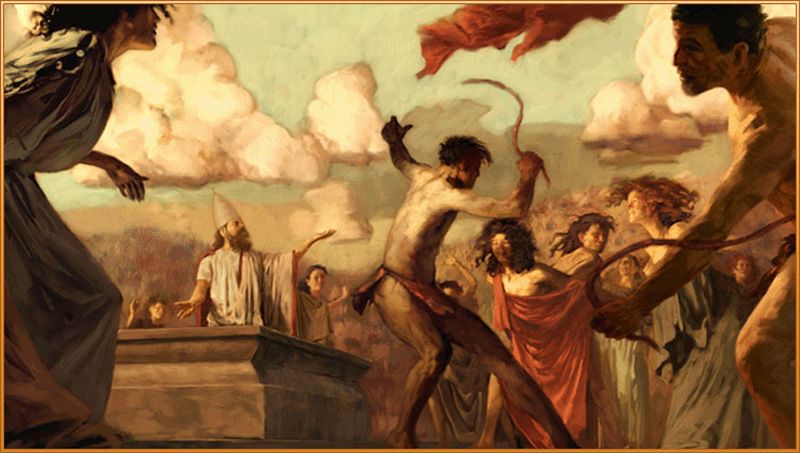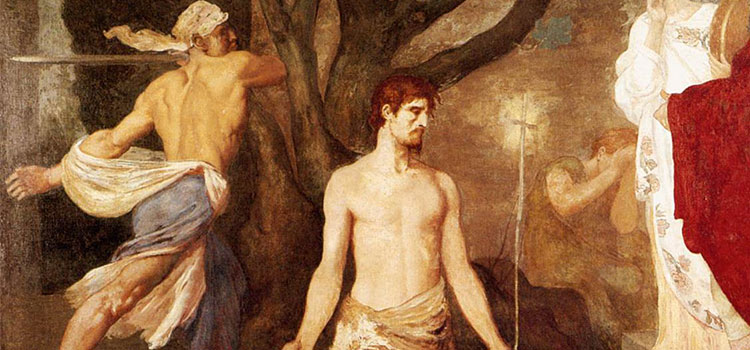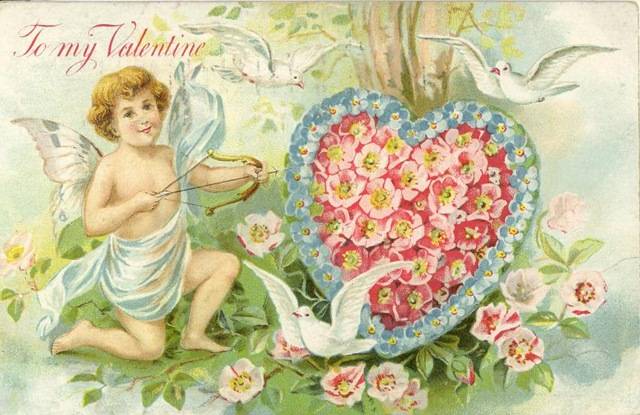February 14, Valentine's Day, is celebrated in the US and in Australia, Canada, France, Mexico, the United Kingdom and other parts of Europe. The origins of the day are muddled and obscured since the original festivity, which is seeped in an ancient ritual of rebirth, fertility, and growth clashed strongly with the traditions imposed by the Catholic church during the "christianization" of Rome. CeremonialSupplies.com, the best one-stop shop on the web for all things ceremonial - groundbreaking shovels and hard hats, shovel display stands and cases, ceremonial ribbon-cutting scissors, grand opening ribbons, military decorations and gifts, corporate clothing, and many more, is proud to bring you this brief and concise history of Valentine's Day.

Valentine's Day Started With The Festival of Lupercalia
The festival of Lupercalia was an annual festival celebrated in ancient Rome and was held between the 13 - 15 of February. Some scholars claim Lupercalia is a pastoral festival, meaning it is related to pastures, land, and farming and very likely originated even before the founding of Rome when early man experienced the coming and going of the seasons and held rituals he believed would influence the weather patterns. The month of February falls in the peak of winter. Anyone who has lived outside the tropics understands the barren landscape of winter - a season associated by the ancients with death and rebirth. The Lupercalia was a major organization that operated like a cult, with its own priesthood called 'the Luperci' who was formed by men between the ages of 20 and 40 and divided into two religious associations; the Quinctiliani, a patrician family of Rome whose members held high offices in the State, and the Fabiani, the most ancient family of Rome. It is interesting to note that during the time of Julius Caesar in 44 BC a third institute was created and called Juliani in honor of Julius Caesar and its first magistrate was Mark Antony. The Juliani was disbanded after Caisar's assassination. The priesthood of the Luperci conducted with great pomp, a sacrificial ritual that entailed the killing of a male goat and a dog at the Lupercal altar. The ceremony was carried out under the supervision of the chief priest. When the blood sacrifice was completed, two members of the Luperci were anointed on their forehead with the blood from the knife used to kill the animals, and then wiped clean. The two chosen members were then expected to laugh. This ended the ritual and opened the official feast during which the Luperci men cut strings or pieces of hide fiber (called februa) from the skin of the sacrificed animals and ran naked (and most assuredly drunk) within the city limits while whipping women who would literally line up for the men to hit them as they believed this would make them fertile. The celebration included a matchmaking ritual in which unmarried men drew the names of unmarried women from an urn and the two were paired for the duration of the festival, or longer if the match was successful. Some of these matches ultimately ended in marriage.

Pregnant women would get in the way of the naked men to be struck with the bloody piece of animal skin as a way of assuring a safe delivery. We know this through the writings of the ancient historian Plutarch who describes Lupercalia: "...many of the noble youths and magistrates run up and down through the city naked, for sport and laughter striking those they met with shaggy thongs. And many women of rank also purposely get in their way, and like children at school present their hands to be struck, believing that the pregnant will thus be helped in delivery, and the barren to pregnancy."
The Catholic Church Outlaws Lupercalia
Pope Gelasius was the head of the Catholic Church from AD 492 to 496 a time considered as the cusp between late antiquity and the early middle ages. He is responsible for banning the festival of Lupercalia and instead combined the martyrdom of at least four men - supposedly all named Valentine and executed by Emperor Claudius around the year AD 270, with the debaucherous festival. According to the "Acta Sanctorum" or "Lives of the Saints" there were several "Valentini" named men who were killed during this time. One was a priest who married Christian couples and helped Christians who were being persecuted and was beheaded by order of Emperor Claudius for refusing to denounce Christ. Another is said to have died in Africa; the third was beheaded for performing a miracle upon an aristocratic family named Asterius, and yet another one was the bishop of Terni who also cured and converted an unbeliever and was also beheaded. Throughout history scholars have dissected the story of St. Valentine's and have suggested there was actually just one Valentine who was beheaded but different stories surfaced about him. There are others who are skeptical that any Valentine ever existed at all and the observance of St. Valentine's day on February 14 was a way for the Catholic church to put a somber note and discourage the reckless sensual pleasures of Lupercalia. Regardless, none of these legends are remotely romantic.

Thank Chaucer, Shakespeare and Cadbury for the Romance in Valentine's Day
More than a thousand years after the festival of Lupercalia was outlawed by the church and replaced instead by the observance of the gory death of one Valentine who may, or may not have lived, the English poet Geoffrey Chaucer, author of "The Canterbury Tales" mentions the February feast of St. Valentine's in connection with the mating of birds and wrote, "For this was on seynd Volantynys day. Whan every bryd comyth there to chese his make." in his poem called "Parlement of Foules." Apparently, birds in England mated during February and this inspired European nobility to send love notes during bird-mating season and in fact, in February of 1415 the Duke of Orleans during his imprisonment in the Tower of London wrote to his wife calling her his "very gentle Valentine." The connection with love birds and February 14 continued and even Shakespeare includes it in Act IV, Scene 5 of "Hamlet" as Ophelia, already losing her mind sings: "To-morrow is Saint Valentine's day, all in the morning bedtime, and I a maid at your window, to be your Valentine."

As time passed St. Valentine's day made its way to the New World and had now become a bit more sweet than its origin, while becoming increasingly popular throughout Europe. February 14 became a day to exchange love notes, poems, and handmade paper cards until eventually in 1913, Hallmark began mass production of Valentine's Day cards and ushered the commercialized big business that the holiday is today.

Dropping the "Saint," Valentine's Day is celebrated today in a big way. As soon as New Year decorations come down, Valentine's Day ones come up. Businesses, shops, office cubicles, and homes everywhere bring out the hearts, the cupids and the red and pink bows as gifts of cards, love notes, candy, chocolates, jewelry and sexy undergarments fly off the shelves. Ironically, over the passage of time, there is more of a trace of the sensual paganism with which the holiday originated and less of the gory details, which have survived. We at CeremonialSupplies.com love the idea of celebrating Valentine's Day in grand style! We'll provide the red carpet and stanchions, the red and pink ribbons, banners, and bows, a step and repeat for your official photo of the event, and you create the version of Valentine's Day that inspires you most! See our other blogs for ideas on ceiling draping, ribbon banners, extra-wide ribbons colorful table runners, and much more! Happy Valentine's Day, with love, from CeremonialSupplies.com! Contact us here for questions or shipping quotes and let Cupid's arrow fly!
